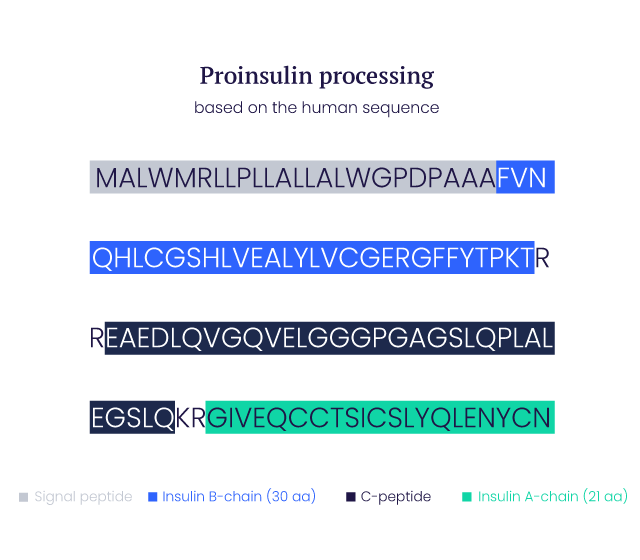Insulin Peptides
Insulin B peptides may cause destruction of pancreatic ß cells
Insulin is a peptide hormone secreted by the beta cells of the pancreas acting through a receptor located in the membrane of target cells – such as liver (where it promotes glucose storage into glycogen and decreases glucose output), as well as skeletal muscle and fat (where it stimulates glucose transport through translocation of GLUT4), and other cells.
Insulin is composed of two peptide chains, A chain and B chain, linked together by two disulfide bonds, and an additional disulfide is formed within the A chain. In most species, the A chain is made up of 21 amino acids and the B chain, 30 amino acids.
Peptides or epitopes of the insulin chains, and insulin receptor fragments/substrates have been identified and used in studies to gain a better understanding of mechanisms involved in insulin signal transduction and other immune-profiling events such as recruitment to CD4 T cells given that insulin is a target of CD4 T cells in type I diabetes.
Proinsulin precursor
Insulin is processed from its proinsulin precursor together with C peptide (connecting peptide). The human insulin protein is composed of 51 amino acids and is a dimer of an A-chain and a B-chain, which are linked together by disulfide bonds.
Type 1 diabetes
Type 1 diabetes, or insulin-dependent diabetes mellitus, is a T cell-mediated disease that results in autoimmune destruction of pancreatic ß cells, to a lack of insulin secretion and hyperglycemia. Insulin autoantibodies and insulin-reactive T cells have been detected in patients with type 1A diabetes, in prediabetic subjects, and in animal models such as the NOD mouse.
Among the insulin epitopes recognized by NOD islet–infiltrating T cells, insulin B chain amino acids 9–23 is reported to be a key peptide. It binds to a class II (MHC) allele called I-Ag7.
The insulin B chain (15-23) is also targeted by islet-associated T cells. This peptide was used in diabetes studies to assay the IFN-b and IL-17 production by diabetogenic CD4 or CD8 T cells.
References
- Nakayama M. et al., J Clin Invest. 117(7): 1835–1843 (2007).
- Nakayama M. Diabetes Metab Res Rev. 27(8): 773–777 (2011).
- Prasad S. et al. J. Autoimm. 39(4) 347-353 (2012)
